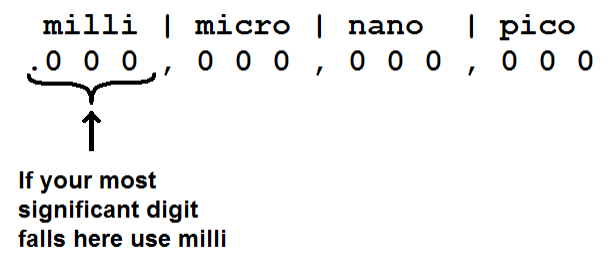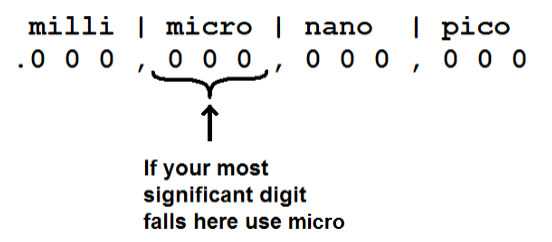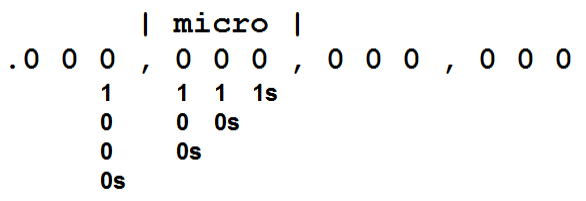| Vocademy |
SI prefixes
Note: when expressing decimal
fractions, commas are not used to the
right of the decimal point. For example, "0.0000123" is the correct way
to express 12.3 1-millionths of something. Here we will use
"0.000,012,3" to help visualize the decimal places and the prefixes to
use.
Working in electronics often requires working with very large and very small numbers, such as thousands of ohms or millionths of farads. To simplify writing these numbers, SI prefixes (International System of Units) are used to represent multipliers. For example, 1,000 ohms is expressed as 1 kiloohm, 1k ohm, or just 1k. A capacitance of 0.000,001 farad is expressed as 1 microfarad, 1μF or just 1μ.
Working in electronics often requires working with very large and very small numbers, such as thousands of ohms or millionths of farads. To simplify writing these numbers, SI prefixes (International System of Units) are used to represent multipliers. For example, 1,000 ohms is expressed as 1 kiloohm, 1k ohm, or just 1k. A capacitance of 0.000,001 farad is expressed as 1 microfarad, 1μF or just 1μ.
| SI Prefixes Commonly Used in
Electronics |
|||
| Name | Symbol | Multiplier | Scientific Notation |
| Tera | T | X 1,000,000,000,000 | 1.00x1012 |
| giga | G | x 1,000,000,000 | 1.00x109 |
| mega | M | x 1,000,000 | 1.00x106 |
| kilo | k | x 1,000 | 1.00x103 |
| milli | m | x 0.001 | 1.00x10-3 |
| micro | μ | x 0.000,001 | 1.00x10-6 |
| |
n | x 0.000,000,001 | 1.00x10-9 |
| pico | p | x 0.000,000,000,001 | 1.00x10-12 |
The prefixes hecto (x100), deca
(x10), deci (x0.1) and centi
(x0.01) are not normally used for electronic units. You may use
centimeters to measure distance by you are unlikely to hear of a
centivolt.
Examples:
In the chart below, each row shows
different representations of the
same value. The last column uses engineering notation.
| 4,700 ohms | 4.7 kiloohms | 4.7 kΩ | 4.70x103 ohms |
| 0.01 henry | 10 millihenrys | 10 mH | 10.0x10-3 henrys |
| 0.0001 farad | 100 microfarads | 100 μF | 100x10-6 farads |
Using prefixes
Large numbers are fairly simple to
add prefixes to. If the quantity is
in the thousands, the prefix is kilo. For example, 1,000 volts is 1
kilovolt, 10,000 volts is 10 kilovolts, 2,500 volts is 2.5 kilovolts.
If a quantity is in the millions, the prefix is mega. For example, 470
million ohms is 470 megaohms. This works the same for billions, for
which the prefix is giga (pronounced with a hard 'G' or a soft 'G,'
either is correct) and trillions, for which the prefix is tera. Here
are some more examples:
| 1,250 volts | = | 1.25 kilovolts (1.25 kV) |
| 33,000 ohms | = | 33 kiloohms (33 kΩ) |
| 1,360,000 hertz | = | 1.36 megahertz (1.26 MHz) |
| 25,000,000,000 hertz | = | 25 gigahertz (25 GHz) |
Another way to look at it is: for
thousands, move the decimal point
three places to the left to convert to kilo. For millions, move the
decimal point six places to the left to convert to mega, nine places
for giga and 12 places for tera.

| Move DP three places to the left |
Mixing prefixes
Sometimes numbers will be specified
with the "wrong" prefix. This is
usually done simply to keep a list of values in the same prefix. For
example, 500,000 hertz should be 500 kilohertz. However, if this
quantity falls in a list where the other values are specified in
megahertz, it may be expressed as 0.5 megahertz. For example, look at
the following table of frequencies.
| 3.5 2.7 700 1.6 |
MHz MHz kHz MHz |
At a glance, you might see the 700 kHz
and think it is 700 MHz. Now, look
at the following list of the same values.
| 3.5 2.7 0.7 1.6 |
MHz MHz MHz MHz |
Here the 700 kHz is it is expressed
in MHz to be consistent with the
other frequencies. It is unlikely that this would be mistaken for
anything other than what it is. Another example is seen on the AM radio
dial. AM radio frequencies are usually expressed in kilohertz, even
though more than half of the allotted band is above 1 MHz. For example,
KSL, in Salt Lake City, broadcasts on a frequency of 1.16 MHz
(1,160,000 Hz). However, this is usually expressed as 1,160 kHz (1160
on the AM dial). Both express the same frequency.
Small numbers may be a bit harder to follow because you may not be used to working with thousandths and millionths, etc. Thousandths of amperes are expressed as milliamperes. For example, 0.001 ampere is 1 milliampere (1.mA), 0.01 ampere is 10 milliamperes (10.mA), 0.0025 ampere is 2.5 milliamperes (2.5.mA). Millionths of farads are expressed as microfarads. For example, 0.000,001 farad is 1 microfarad (1.μF). Here are some more examples:
Small numbers may be a bit harder to follow because you may not be used to working with thousandths and millionths, etc. Thousandths of amperes are expressed as milliamperes. For example, 0.001 ampere is 1 milliampere (1.mA), 0.01 ampere is 10 milliamperes (10.mA), 0.0025 ampere is 2.5 milliamperes (2.5.mA). Millionths of farads are expressed as microfarads. For example, 0.000,001 farad is 1 microfarad (1.μF). Here are some more examples:
| 0.25 volt | = | 250 millivolts (250 mV) |
| 0.000,022 farad | = | 22 microfarads (22 μF) |
| 0.016,7 watt | = | 16.7 milliwatts (16.7 mW) |
| 0.000,000,000,33 farad | = | 330 picofarads (330 pF) |
To convert thousandths to milli, move
the decimal point three places to
the right. To convert millionths to micro, move the decimal point six
places to the right. Nine places to the right converts to nano and 12
places converts to pico.

| Move DP three places to the right |
Some people can use the following
visualizations, but they don't work
for everyone.
 |
|
For example: 0.245 A = 245 mA
0.033 A = 33 mA 0.007 A = 7 mA 0.005,2 A = 5.2 mA |
 |
For example: 0.000,300 A = 300 μA
0.000,025 A = 25 μA 0.000,004 A = 4 μA 0.000,007,5 A = 7.5 μA |
As with large numbers, some values
will be specified with the "wrong"
prefix. The most common example is millifarads and nanofarads. Milli
and nano are rarely used to specify farads (at least in the U.S.).
Instead, 0.001 farad would be 1,000 microfarads, 0.000,000,010 farad
would be 10,000 picofarads. Look at the following list of capacitances:
| 470 2.7 1,500 0.47 |
μF μF μF μF |
You might think of 1,500 μF as 1.5 millifarads (1.5 mF), but
that is
rarely used in labeling capacitors (see confusion alert below). Likewise, you might be tempted to
express 0.47 μF as 470
nanofarads (470 nF), but that is also rarely used in labeling
capacitors.
Confusion Alert!
Many capacitors
may be labeled with “mF” (lower case “m”). In this case, "mF" means
microfarads, not millifarads. This is supposedly because the labeling
equipment owned by the manufacturers is not capable of printing the
Greek letter mu (μ).2 Capacitors are also commonly labeled with “MF”
(upper case “M”). These are not megafarads. They are still microfarads.
Also, even though it
is entirely proper and most common to express something like 0.001
watt as 1 milliwatt (1 mW), you might find it expressed as 1,000
microwatts (1,000 μW). They are both the same quantity. It just depends
on the context and who is expressing it. Here are some examples.
| 0.002 A | = | 2 mA | = | 2,000 μA |
| 0.002,45 W | = | 2.45 mW | = | 2,450 μW |
| 0.000,35 A |
= | 350 μA | = | 0.35 mA |
| 0.000,000,003,3 F | = | 0.003,3 μF |
= | 2,500 pF |
Some people are helped by the
following visualization (based on the
visualizations above).

This illustrates that each range has
a 1's column, a 10's column and a
100's column (remember your 5th-grade arithmetic). It also shows that
the 1's column of the milli group is also the 1,000's column of the
micro group. Think of 0.002 amps as two times 1,000 microamps or 2,000
microamps.
Exercise:
Make the following conversions. Be sure to convert to the specified units. For example, 0.012 amperes would most likely be specified as 12 mA. However, if the problem asks for μA, specify the answer as 12,000 μA.1
Exercise:
Make the following conversions. Be sure to convert to the specified units. For example, 0.012 amperes would most likely be specified as 12 mA. However, if the problem asks for μA, specify the answer as 12,000 μA.1
| 0.022 A = ______ mA | 0.000,23 F = ______ μF | 33,000 ______ kΩ |
| 250,000 Hz = ______ kHz | 250,000 Hz = ______ MHz | 0.2 A = ______ mA |
| 0.003 W = ______ mW | 0.003 W = ______ μW | 0.000,23 V = ______ mV |
| 470 kΩ = __________ Ω | 2.7 μA = __________ A | 500 mA = ________ A |
Micro-micro farads
The term "pico" for one trillionth is
fairly new. Up to the mid
1960s, the term micro-micro (1 millionth of 1 millionth) was used
instead. Therefore, in older documents, you might find the term
micro-microfarad ( μμF) used for trillionths of farads
instead of
picofarads (pF).
Formal usage
In formal documentation, observe
proper capitalization (see the tables
above). Note that the SI symbols for Tera, Giga and Mega use upper case
where the rest of the SI prefixes use all lower-case. In formal
documentation, “amps” should never be used in place of “A” or “amperes.”
SI Prefixes
| 1 | Answers to exercise: |
|
22 mA | 250 kHz | 3 mW | 470,000 Ω | |
230 μF | 0.25 MHz | 3,000 μW | .000,002,7 A | |
33 kΩ 200 mA 0.23 mV 0.5 A |
| 2 | Pronounced something like “myew” (one syllable). |
| Vocademy |
